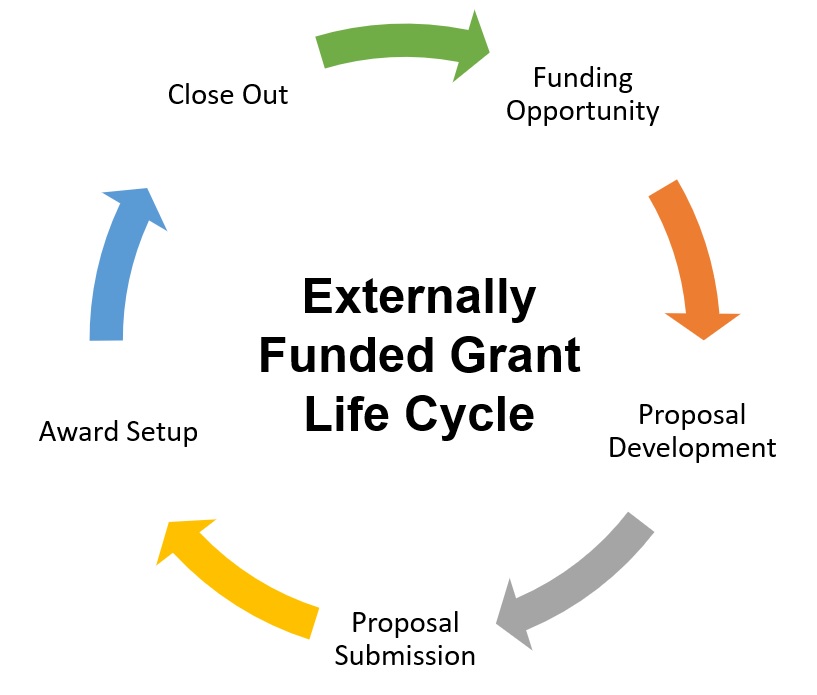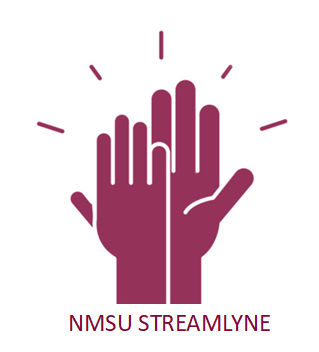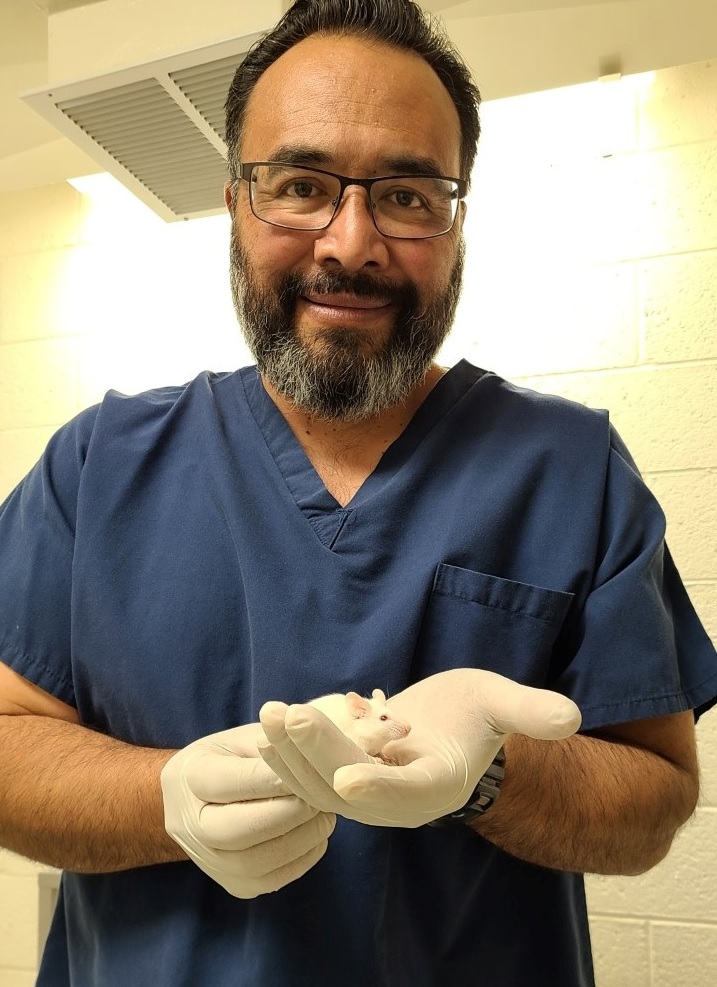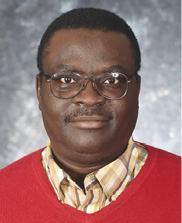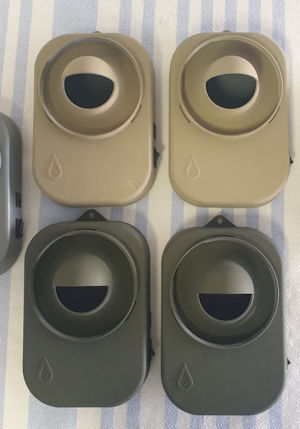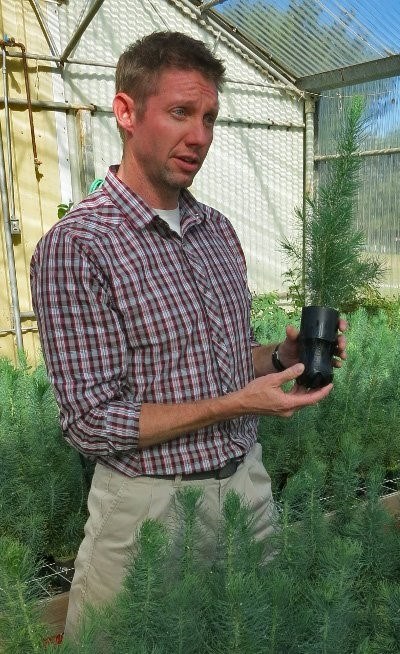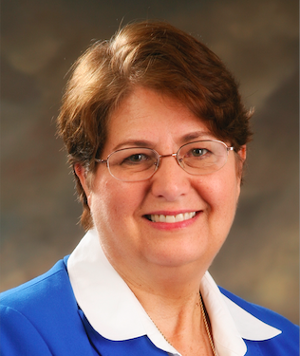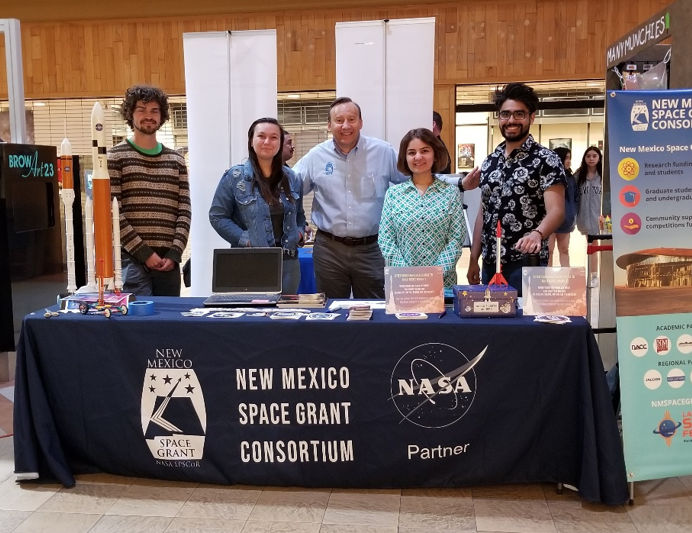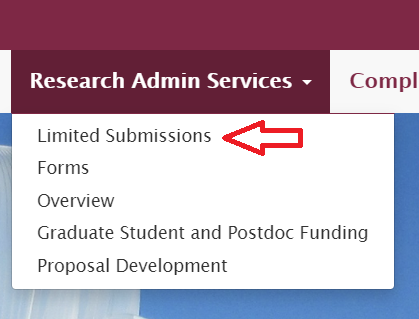 |
|
Ideas are Yours, Quality of Externally Funded Grant Lifecycle Is All of Our Responsibilities
Ms. Alisha Giron, Assistant Vice President, and Dr. Luis Cifuentes, Vice President for Research, Creativity, and Strategic InitiativesThe proverbial It takes a village to raise a child from African cultures cleverly describes what it is like for a funded grant proposal to make its way through its lifecycle via the entire research administration community. Beginning with much thought and deliberation, that sometimes takes years to appropriately conceptualize, the foundation of the proposal is usually developed by a single Principal Investigator (PI) that has the gumption to propose a novel concept, theory, or project. More and more, teams are formed to hone the concept. This idea is then nurtured with factually-grounded support that eventually manifests its way into a nicely packaged application or pitch to a sponsoring agency with hopes of being received by accepting, discerning hands. If the PI is fortunate to have their effort evaluated and subsequently approved for funding, once again, elements of this special work makes its way through multiple offices like Research Administration Services (RAS) for a second visit for award negotiation & acceptance, Research Integrity & Compliance for potential protocol amendment/development, Sponsored Projects Accounting (SPA) for account & financial reporting set up, Human Resource Services for hiring/staffing, Procurement Services for large purchases, and through College/Unit research support offices for ongoing post-award activities. Many offices, clearly, play a significant role in the grant lifecycle until the project has been finally closed out after several years in some cases. And the Office of the Vice President for Research (OVPR), Strategic System Services, and College/Unit research support offices are all equally charged with ensuring that PIs and the researcher community are well served while complying with sponsor and institutional guidelines. After all, many of us represent the A in the F&A (Facilities & Administration) rate that is assessed on every grant. The OVPR has received a lot of interest and support of the Streamlyne eRA (electronic Research Administration) system implementation. Streamlyne offers a unique opportunity for many moving parts to work together as it offers enhanced efficiencies for proposal development, award negotiations, subaward issuance & invoice review, and compliance committee process improvements (e.g., Institutional Review Board, Institutional Animal Care & Use, Institutional Biosafety). We are currently working closely on a more efficient approach to the RAS to SPA handoff via the Streamlyne Award Module. This will take careful coordination and commitment from these vitally important units. The University of New Mexico is on the same path and we are collaborating and sharing best practices. For the latest on the Streamlyne implementation, you can always view the Research website at https://research.nmsu.edu/News/Streamlyne.html. The details of the grant lifecycle are unique for every PI, sponsor, project, etc. The offices and functions that touch this process are each afforded an integral piece of the puzzle. All of this occurs while we are simultaneously looking for the next great opportunity to propose another novel idea. We thank everyone in the research community for your continued dedication to the research mission and your commitment to enhancing our research portfolio. This work is not easy. We commend the collective effort in doing our best to attain our wildest ambitions. |
|
Streamlyne Updates: Research Compliance Module Going Live on May 16, Award Module on June 28By Dr. Phillip De Leon, Associate Vice President for ResearchStudent and Non-NMSU Employee Access to Streamlyne Compliance Module Students needing access to the Streamlyne compliance module for IACUC and IRB applications, will request access via (link will be live on May 16, 2022) Once the request has been made, the student's Streamlyne role will changed by Research Administration to allow access. Non-NMSU employees, e.g. research collaborators, needing access to the Streamlyne compliance module for IACUC and IRB applications, will request access via a Streamlyne request form (after May 16, 2022) found on the sidebar menu at the NMSU Streamlyne Support Page. Please note the instructions at the top of the form for this particular request. Award Module The award module is the final module to be implemented in the Streamlyne eRA system. When an award is made, an award record is created in Streamlyne, linked to the proposal in the proposal module, and additional data entered. The award module is currently being configured by members of RAS and SPA. At this time there is some risk of delay due to issues beyond OVPR control. Nevertheless, the project team is moving forward albeit slowly on this module. The award module integration with Banner, i.e. award setup is currently being tested. |
|
All IRB Submissions to Go through Streamlyne
By Ms. Michelle Gavin, Research Integrity CoordinatorThe NMSU Institutional Review Board (IRB) and the Office of Research Integrity and Compliance would like to welcome Streamlyne as the new enterprise research eRA (electronic Research Administration) system. Streamlyne will be used to address all of NMSU’s research administration needs from pre-/post-award and proposal through research compliance and conflict of interest. The research compliance module, which includes IRB and IACUC activities, will go live on May 16th, 2022. Starting on that date, all IRB submissions including new applications, modifications, renewals, etc., will now be entered and managed through the Streamlyne system which is replacing the current Maestro Review System.
Streamlyne Resources:
We again ask for your patience and support throughout the transition. |
|
Transition to Streamlyne: Recognizing TeamsBy Dr. Hamid Mansouri Rad, Senior Proposal Development Specialist, RASWe would like to acknowledge the efforts of the following outstanding individuals who have been instrumental in transitioning to Streamlyne: Implementation Team
|
|
Animal Care Plan for Emergencies
By Dr. JoAnne Dupre, Director, Compliance AdministrationAs the spring semester ends and staffing changes for the summer months, this is a good time to review the lines of communication and training for disaster plans. NMSU departments and units maintain emergency action plans (EAP), through the Office of Environmental, Health and Safety. Resources for developing and updating the EAP are available on the NMSU Emergency planning webpages. Units that have research animals must ensure that animal care is encompassed in the EAP or in a supplemental document, up-to-date and available to employees and emergency personnel. Research animal facilities are required to maintain written contingency plans to provide for humane handling, treatment, transportation, housing, and care of their animals in the event an emergency or disaster. The documented contingency plan must:
The U.S. Department of Agriculture published new regulations for the Contingency Plan and training in the Federal register in December 2021, requiring a written plan to be in place by July 5, 2022, and for personnel to be trained on the plan elements within 60 days. New employees must be trained within 30 days of their start date, and written records of the training and annual review are required. The USDA Animal and Plant Health Inspection Service provides a template for optional use, APHIS Form 7093, and other tools for animal welfare at www.aphis.usda.gov. For more information or questions about Contingency Plans for animal care, we encourage you to contact the IACUC Chair, Dr. Shanna Ivey, or send a message to Research Integrity and Compliance by email to ric_admin@nmsu.edu or by phone to (575) 646-7177. |
Alfredo Montoya, Manager,
|
Updates to Research Integrity and Compliance Webpages
By Dr. JoAnne Dupre, Director, Compliance AdministrationThe webpage addresses have changed for Research Integrity and Compliance webpages. Please update your bookmarks, and look for news and announcements coming soon on these pages.
Contact Research Integrity and Compliance staff by email to ric_admin@nmsu.edu or by phone to (575) 646-7177. |
|
NMSU Library Receives $350,000 Prestigious NEH Award
By Dr. Hamid Mansouri Rad, Senior Proposal Development Specialist, RASCongratulations to Dr. Monika Glowacka-Musial, a metadata librarian at NMSU Library; Mr. Dennis Daily, Department Head of NMSU's Archives and Special Collections; and Ms. Jennifer Olguin, NMSU's Rio Grande Historical Collections Archivist for their National Endowment for the Humanities (NEH) award. Led by Dr. Glowacka-Musial the principal investigator (PI), the project aims to digitize and increase access to 15,000 pages of correspondence from the Amador family, a Mexican-American family of prominence in the border region of southern New Mexico and northern Chihuahua, Mexico during the 19th and early 20th centuries. "The letters illuminate the struggles and triumphs of a Mexican family as they negotiate a bi-cultural and bi-national life on the US-Mexico border in the wake of the Mexican American War (1846-1848)," states Dr. Glowacka-Musial. As co-PI Dennis Daily explains, these letters have been housed in the Archives and Special Collections of the NMSU Library, and have served researchers from a variety of humanities and social science disciplines for more than 50 years. These materials have been freely available on-site since the 1970s and the collection has steadily gained a dedicated following of users, academic and public, who appreciate its unique perspective and massive scope during an important period in the development of the United States. Ever-increasing demand for access to the Amador collection has generated a need to make the materials widely available online in digital format. For more information please contact Dr. Glowacka-Musial at monkiagm@nmsu.edu. |
Dr. Monkia Glowacka-Musial (left), Ms. Jennifer Olguin, and Mr. Dennis Daily, NMSU Library |
Recognizing NMSU's Large Proposal Submitters
By Dr. Hamid Mansouri Rad, Senior Proposal Development Specialist, RASCongratulations to Drs. Timothy Wright and John Idowu for their recent large proposal submissions. Dr. Wright, a Professor in Biology, led a team from the Colleges of Agriculture, Consumer and Environmental Sciences and Arts and Sciences that submitted a $7.2 million proposal in March 2022 to National Institutes of Health to construct a new wild animal vivarium, aviary and insectary at NMSU. As Dr. Wright explains, this new building would house both wild animal disease models such as rodents, bats and birds as well as invertebrate disease vectors such as mosquitoes, ticks, and bedbugs. The new facilities will include animal housing, procedural rooms, analytical and physiology testing labs, a microscopy room and support space. The building will adjoin and complement a new lab animal vivarium already under construction with state bond funding that includes housing for lab animal models, behavioral and procedure rooms, diagnostic and analytical labs, a large surgery suite and support space. The combined complex, to be called the Biomedical Research Facility, will support NMSU’s biomedical research strengths in emerging infectious diseases, cancer and health disparities in underserved populations, enhance training of students from underrepresented populations, and promote research addressing the health of border communities and minority populations in New Mexico. Dr. Wright also collaborated with University of California Los Angeles (UCLA) and Rockefeller University (RU) to submit a large proposal to the National Science Foundation. The project would examine how individual variation in vocal production learning is associated with variation in gene co-expression networks. These questions will be investigated in naturalistic flocks of two bird species that differ in sexual dimorphism, the capacity for life-long learning and the presence of a hypothesized neuroanatomical circuit duplication. As the lead of the NMSU effort with a funding request of $1 million, Dr. Wright will oversee research on one of these species, the budgerigar. He will also develop a course-based undergraduate research experience (CURE) at NMSU that will then be adopted at the other two institutions. The proposed effort will also establish a cross-institutional research-training program in neuroscience (CIRP-Neuro) that will recruit URM, 1st generation, and other students from the diverse communities in which NMSU, UCLA and RU are embedded. For more information about these two proposals, please contact Dr. Wright at wright@nmsu.edu. Professor and Extension Agronomist in the Department of Extension Plant Sciences, Dr. John Idowu submitted a multi-million-dollar proposal to USDA NIFA Climate-Smart program in collaboration with University of California at Davis as the lead. NMSU’s portion of the effort amounts to $5.5 million. Led by Dr. Idowu, the NMSU team will carry out research and market development activities in New Mexico. These activities will include the establishment of biochar field trials in underserved regions of New Mexico and West Texas, including those used by producers on Navajo and Zuni reservations. NMSU team will also recruit producers from other rural, and otherwise underserved communities throughout New Mexico and West Texas, including El Paso County. In addition, the team’s activities will involve collaborating with Dr. James Armonette (Washington State University) to assess carbon dynamics and greenhouse gas emissions and associated crop and soil health factors, including microbial activity. The team will also evaluate low-cost biochar production and monitoring technologies appropriate for small farmers to implement in conjunction with advanced sensor technologies so that biochar quality standards can be validated across production scales. For more information, please send email to jidowu@nmsu.edu. |
Professor Timothy Wright,
|
Arrowhead Center Programs Spur Economic Development in New MexicoBy Dr. Kathy Hansen, Director, Arrowhead CenterHydration backpacks have many benefits to users, but they pose issues of water being retained in the material after use, presenting an ideal medium for bacteria growth. Arrowhead client Trail 9 Outdoors designed the HyDry Pod to address this issue. Short for Hydration System Drying Pod, the HyDry Pod accelerates the drying of hydration backpacks by circulating ambient air through the bladder, drink tube, and mouthpiece. Minimizing moisture greatly reduces the growth of mold and bacteria. |
|
John T Harrington Forestry Research Center at Mora
By Ms. Claire Montoya, Program Manager, Agricultural Experiment Station Administration, ACESThe John T. Harrignton (JTH) Forestry Research Center has the largest forest nursery and seed bank in the southwestern US with a growing capacity of 300,000 seedlings per year using over 35 different native tree species. Additionally, the research program at the Mora Research Center is one of only five programs in the United States dedicated to investigating the entire “reforestation pipeline” (from seed to nursery to tree planting), especially as it relates to post-fire reforestation. The expertise and valuable information gathered from the long-term research plots at the Research Center are commonly sought after from neighboring institutions in the four corner states (NM, AZ, UT, and CO). Examples of long-term research topics conducted at the Research Center include seed transfer guidelines in response to climate change, planting strategies that promote long-term improvements to water resources, and development of drought-conditioning seedlings for tree planting. Maintaining these long-term research plots at the Research Center is critical to restoring forest systems throughout the southwestern US. It is important to note that the purchase of this property will support the mission of the proposed New Mexico Reforestation Center by helping to meet current and future reforestation needs in New Mexico through its comprehensive seed bank, nursery, and planting programs combined with research, education, and outreach activities. The Mora Research Center is currently under evacuation from the wildfires that are occurring in northern NM. Seed from the seed bank has been collected, along with computer servers and other critical items. Fires lines were dug around the greenhouse, which houses about 90,000 seedlings, and NMSU faculty and staff irrigated before evacuating. For more information, please contact me at ccortner@nmsu.edu. |
Dr. Owen Burney, Associate Professor and Superintendent, JTH Forestry Research Center |
Legal Resources in Grant Writing and Research: An Introduction to NMSU's Legal Research Databases
By Dr. Julie Reagan, Assistant Professor, Department of Public Health SciencesWhether looking up a single regulation needed for a grant proposal or conducting a full legal analysis for a research project, maneuvering through legal databases can be daunting. In this presentation, prepared for NMSU’s PI Academy faculty members, Dr. Julie Reagan will provide an overview of legal databases available through NMSU’s library. The lecture will be intended for an audience of non-attorneys and will be tailored for grant writing and research. Dr. Julie Reagan holds a Ph.D. in Public Health and is also an attorney with over 20 years of practice experience in state government, working primarily at public health agencies. Dr. Reagan is a nationally recognized legal expert in public health law. In 2018, she was awarded the Jennifer Robbins Award for the Practice of Public Health Law by the American Public Health Association, Law Section. You can contact Dr. Reagan directly at jreagan@nmsu.edu. Dr. Reagan’s presentation will be given on Tuesday, May 10 at 3 pm via Zoom. All interested are invited to attend, please contact Cindy Ramirez at cindyram@nmsu.edu for Zoom invite details. |
Dr. Julie Reagan, Public Health Sciences |
Survey on Prevalence of Depression and Sleep Disorders in NMSU Population during COVID-19By Dr. Hamid Mansouri Rad, Senior Proposal Development Specialist, RASDr. Humairat Rahman, a faculty researcher in the Department of Public Health Sciences, is cordially inviting NMSU faculty, staff, and students to participate in a study assessing beliefs and experiences of depression and sleep disorders during the COVID-19 pandemic. Participating in this study entails responding to a confidential online survey that will take approximately 20 to 30 minutes.
For more information please contact Dr. Rahman at hrahman@nmsu.edu or call (575) 646-5469. |
|
Las Cruces Space FestivalBy Dr. Paulo Oemig, Director, New Mexico Space Grant ConsortiumFour NMSU graduate students helped the New Mexico Space Grant Consortium (NMSGC) kick-off the Las Cruces Space Festival (LCSF) at the Mesilla Valley Mall on Thursday, April 7th. Rose Ghasemi, Leonardo Escamilla (both PhD students from College of Engr.), Shannon Pestovich (PhD student, Arts and Sciences) and Trevor Roberts (Masters, ACES). Students shared their experiences at NMSU, their focus of study and engage the public with NMSGC designed educational activities and discussed NASA’s Artemis mission. NMSGC sponsored the 32nd Waste-management Education and Research Contest (WERC) or better known as the Environmental Design Contest. The contest took place over the span of three days, kicking-off on April 10th. Dr. Paulo Oemig, NMSGC Director, worked with Dr. Morgan Abney, NASA Environmental Control and Life Support System (ECLSS) Technical Fellow and Dr. Ginger Scarbrough, WERC Program Manager, to design the NASA task: ‘Cleaning Lunar Regolith from Spacesuits.’ The harsh conditions of the lunar environment include regolith dust which is very fine and sharp. Teams were tasked with designing and demonstrating a method for cleaning lunar regolith dust from spacesuits as astronauts enter a lunar vehicle or habitat. Civil Engineering Associate Professor Dr. Douglas Cortes served as the faculty advisor for the student team representing NMSU. Students Jose Araiza, Miguel Olivas, Daniela Moreno, Erick Martinez, Mehran Pourakbar, and Randy Ferrell outperformed all other teams on this task. NMSGC supports Dr. Cortes’ research on regolith mining and in-situ resource utilization (ISRU) using bio-inspired robots. New Mexico Space Grant Scholars presented their research progress at the Second Annual Statewide Virtual Student Research Colloquium on April 21st and 22nd. Space Grant Scholars are students who have been awarded a Space Grant scholarship (undergrad) or fellowship (graduate). The colloquium is an opportunity for students to share results from their science investigations and engineering design challenges of relevance to NASA. Students asked questions about each other’s work and learned about research programs from different fields and across New Mexico universities. All students acknowledged the importance of the NMSGC scholarships and fellowships in enabling them to focus on their studies. Space Grant scholarships are competitively awarded and the demand is greater than the funding available. The current application cycle has recently closed. For more information send email to poemig@nmsu.edu. |
From left, Trevor Roberts, Shannon Pestovich, Dr. Paulo Oemig, Rose Ghasemi, and Leonardo Escamilla |
Limited Submission Funding OpportunitiesBy Dr. Hamid Mansouri Rad, Senior Proposal Development Specialist, RASResearch Administration Services maintains a list of limited submission funding opportunities for NMSU research community. The list is accessible through a link on the Research website, through the Research Administration tab. NMSU users can also access the list directly on SharePoint. We encourage NMSU researchers to periodically visit the site and if they are interested in any of the opportunities to please inform us by sending email to ras@nmsu.edu. |
|
Pivot Funding Opportunity DatabaseBy Dr. Hamid Mansouri Rad, Senior Proposal Development Specialist, RASThis is a reminder that in order to assist NMSU faculty and staff in locating external funding opportunities, the RCSI has purchased a subscription to ProQuest’s Pivot available at https://pivot.proquest.com/session/login.
To request a one-on-one or group Pivot training, send email to hamid@nmsu.edu. |
|
Graduate School |
|
Driving Improvements in the Graduate School
By Dr. Carol Flinchbaugh, Associate Professor of Management and Interim Associate Dean, Graduate SchoolThe Graduate School has experienced improvements during the 2021-22 academic year. These gains wouldn’t have occurred without collaboration across many units. Notably, our graduate students led many of these initiatives. For some time, the Graduate School has used graduate assistants for daily service operations, such as answering phone calls or directing emails appropriately. Our service function relies on their efforts. This year, we’ve provided graduate assistants with experiential learning in designing and maintaining webpage, creating social media posts to improve communications, and developing automated forms and instructional tutorials and workshops on Slate. Also, students seeking health-related degrees have led the Graduate Wellness Initiative, conducting a needs assessment to assess wellness, and leading a range of activities from meditation, wellness walks, and sporting events. In sum, their efforts have led to over 25 Slate tutorials, new graduate program descriptions on the Graduate School webpage (pending), and 3,000+ users on social media with a 100% increase since November 2021. We are grateful for our students’ accomplishments! |
|
Questions and comments regarding NMSU’s Research Digest should be directed to Hamid Mansouri Rad, Ph.D. at hamid@nmsu.edu, (575) 646-6429. |
|
